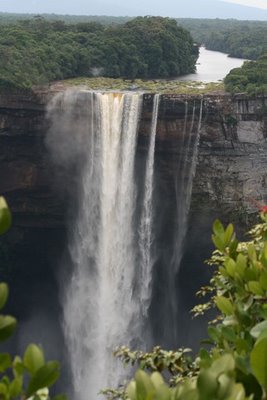 The falls held us in its thrall as we wolfed down the best meal of the trip-homemade Indian curry wraps, still piping hot, wrapped in foil. Nothing tastes better than good hot food, outdoors.
The falls held us in its thrall as we wolfed down the best meal of the trip-homemade Indian curry wraps, still piping hot, wrapped in foil. Nothing tastes better than good hot food, outdoors.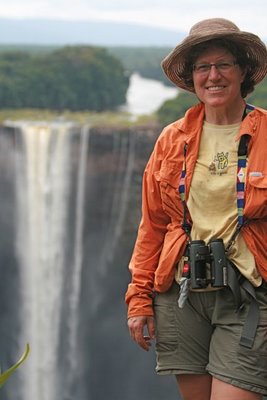 Life IS good. Even at 90 degrees and who-knows-what humidity. It was SO HOT.
Life IS good. Even at 90 degrees and who-knows-what humidity. It was SO HOT.Kaieteur Falls is not just beautiful. It's also a brewery for biodiversity. Think 20,000 species of plants on the Shield. No wonder I had not the faintest clue what I was looking at most of the time.
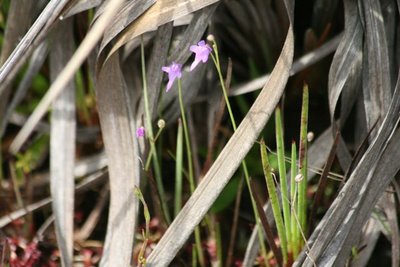 I think these tiny purple jobs were orchids, but...
I think these tiny purple jobs were orchids, but...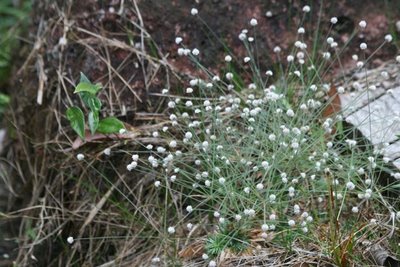 who knows what this little grassy but not grassy pompom thingy could be? It's weird for a Science Chimp to look at something and not even be able to get it down to family, much less genus or species. Caryophyllaceae? Beats me.
who knows what this little grassy but not grassy pompom thingy could be? It's weird for a Science Chimp to look at something and not even be able to get it down to family, much less genus or species. Caryophyllaceae? Beats me. 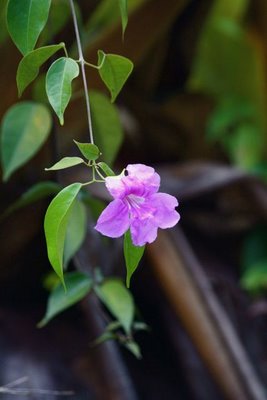 Bignoniaceae? Dunno. Pretty vine, though.
Bignoniaceae? Dunno. Pretty vine, though.It's also sort of fun to be forced to shrug and appreciate a strange plant without naming it...for awhile. This one was blooming, innocent of leaves or anything but a golden flower, on the forest floor. Huh?
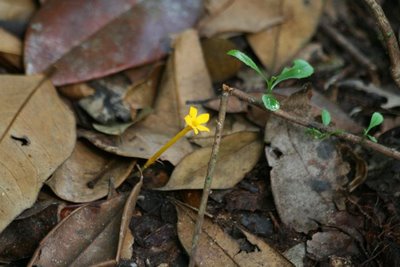 My inner Chimp was fretting badly on this trip, wanting to know, wanting to know.
My inner Chimp was fretting badly on this trip, wanting to know, wanting to know.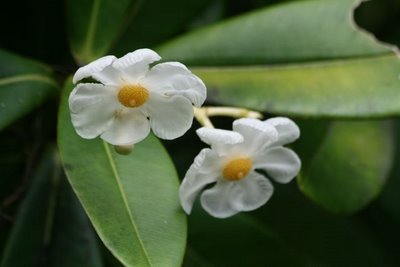 Dunno. Arggh. A huge rhododendron-like shrub with very un-rhody flowers, reminiscent of those of the mayapple. For all I knew I was looking at something that occurs nowhere else.
Dunno. Arggh. A huge rhododendron-like shrub with very un-rhody flowers, reminiscent of those of the mayapple. For all I knew I was looking at something that occurs nowhere else.Like these CARNIVOROUS BROMELIADS. Yes. I mean, what gives with a carnivorous bromeliad? See how it's yellow-- has very little, if any, chlorophyll? Doesn't need it--it's eating bugs.
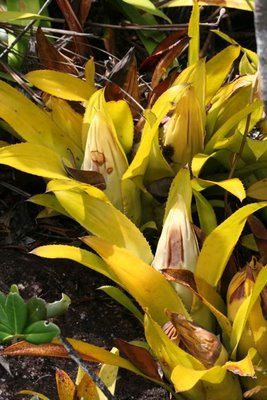 I think I was told that they occur nowhere else in the world. How cool is that, to see such a rare endemic, that makes its living like no other bromeliad?
I think I was told that they occur nowhere else in the world. How cool is that, to see such a rare endemic, that makes its living like no other bromeliad?I knew these were sundews and damselflies. Whew. Good to know something, no matter how small.
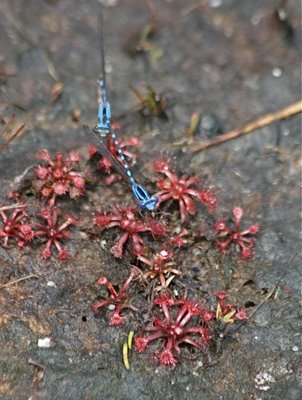 I just wanted to put a name on everything. Is it any wonder daughter Phoebe's middle name is Linnea, for Carolus Linnaeus?
I just wanted to put a name on everything. Is it any wonder daughter Phoebe's middle name is Linnea, for Carolus Linnaeus?From the air, I saw the strange golden leaves of a bizarre plant, and wondered aloud what it could be, growing in such profusion near the falls. Fortunately we were able to ground-truth the sighting with a good hike through the odd low forest around the falls.
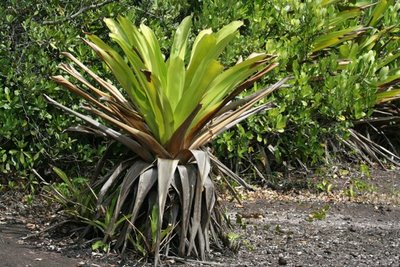 The mystery plants were tank bromeliads Brocchinia micrantha, only the world's largest bromeliad! Yeeps! They were beyond huge. Here are some people for scale.
The mystery plants were tank bromeliads Brocchinia micrantha, only the world's largest bromeliad! Yeeps! They were beyond huge. Here are some people for scale.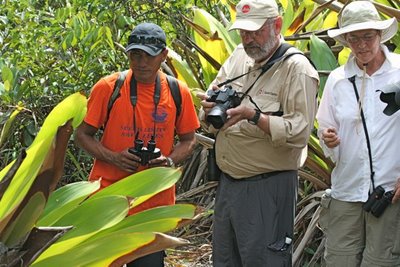 And they grow only here, at Kaieteur Falls.
And they grow only here, at Kaieteur Falls.But it got better. In the rainwater caught in the bromeliad's leaf junctions were tiny frogs--here's a female or juvenile.
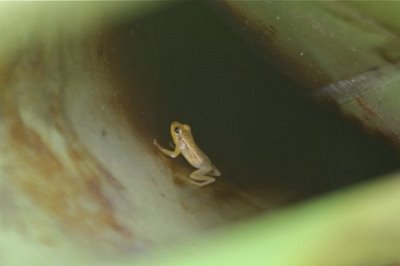 They were golden poison-dart frogs Colostethus beebei. These entrancing creatures live their entire lives in the pools in tank bromeliads--egg, tadpole, adult; egg, tadpole, adult. Amazing.
They were golden poison-dart frogs Colostethus beebei. These entrancing creatures live their entire lives in the pools in tank bromeliads--egg, tadpole, adult; egg, tadpole, adult. Amazing. 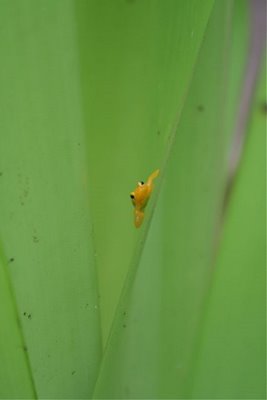 Because it showered several times during our hike, I understood how they could accomplish this. The enormous slick bromeliad leaves channel the rainwater down to their bases, where it sits and accumulates all kinds of detritus along with frog tenants. This is what nourishes the plant. I watched in fascination as the leaves caught rain and ran it into their "tanks." Every plant had at least one frog, some many more. How I wished Liam and Phoebe had been along to find frogs in each plant--it would have been like an Easter egg hunt for them.
Because it showered several times during our hike, I understood how they could accomplish this. The enormous slick bromeliad leaves channel the rainwater down to their bases, where it sits and accumulates all kinds of detritus along with frog tenants. This is what nourishes the plant. I watched in fascination as the leaves caught rain and ran it into their "tanks." Every plant had at least one frog, some many more. How I wished Liam and Phoebe had been along to find frogs in each plant--it would have been like an Easter egg hunt for them.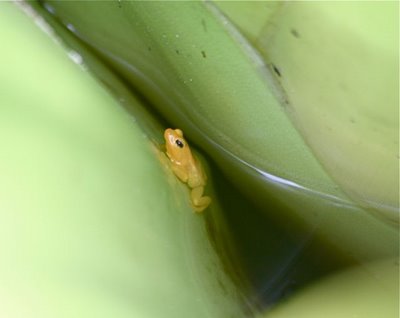 But don't touch--they're highly toxic! How can something so appealing be so poisonous?
But don't touch--they're highly toxic! How can something so appealing be so poisonous?About thirty miles up the river live 500 members of the Patamona tribe. The falls is named for Chief Kai, who, legend has it, went over the falls in a canoe, sacrificing himself to the gods, to save his village from invasion. The Patamonas will likely be instrumental in any ecotourism that goes on in this undeveloped, pristine place. It was amazing to me to see such a stunning natural wonder, such a diverse ecosystem, left so unspoiled and untrammeled. There are no developed roads; you can only get there by plane. And the single accommodation near the falls is just an open shanty with a few hammocks hanging in it. You can see its red roof in this picture. No skyscrapers, no casinos, no condos...just a shanty.
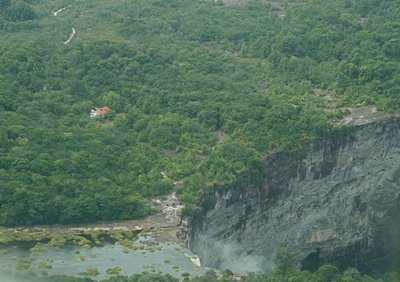 That made my heart sing, but I also wondered how this place would be preserved if people can't get to it to appreciate and study it, to stay there and soak up its beauty and wonder. We were on the ground floor, no, the basement of ecotourism here, looking at what might be. I felt like an early explorer beholding Yellowstone for the first time, knowing that people would want to see it, and in the next thought wondering what would become of it when they did.
That made my heart sing, but I also wondered how this place would be preserved if people can't get to it to appreciate and study it, to stay there and soak up its beauty and wonder. We were on the ground floor, no, the basement of ecotourism here, looking at what might be. I felt like an early explorer beholding Yellowstone for the first time, knowing that people would want to see it, and in the next thought wondering what would become of it when they did.






20 comments:
Wow, your trip to Guyana looked wonderful and fascinating. So much to see and take in. Lovely.
The waterfall is stunning. I can almost hear it and feel the mist. But, the frogs stole my heart.
Those little froggers are so cute. I always thought that highly poisonous frogs were almost neon bright to let others know not to touch. These guys look very normal.
Wonderful description of the vibrancy of life--even if you couldn't name it all.
I hope that such a place isn't discovered--because it will be chopped down, rolled over, polluted, destroyed by someone--all for no good purpose.
That mystery plant reminds me of Armeria. Love the little froggies!
I can't imagine the feeling of being surrounded by things you'd only see in that one place, ever. So humbling and exciting! So different than anything we have here. What a great journey Julie.
Wow - awesome little frogs! I'm smitten!
Love the frog photos.
Have you stopped flinching and twitching from not KNOwing what every thing was?
I can hardly type. Blogging it brings the twitching back.
NW Nature Nut, I thought it looked like sea thrift, too-hence the Caryophyllaceae reference-but it was much grassier, with leaves going up the flower stems, and I couldn't see any petals to count on the florets. Tropical vegetation delights me and drives me nuts at the same time.
That little yellow flower looks sorta like a disembodied false jasmine blossom.
How come the cutest frogs are the most dangerous to kiss?
Ah, Catbird, if only I had the answer to that.
Ooooooh, my goodness! The photos, the flora, the fauna, the froggies! But most of all the wonder. Your closing about feeling like a pioneer discovering Yellowstone gave me the shivers. Gorgeous all around.
Thanks again for the color and wonder! Day 8 without power here in NH Pioneer Land and 2 snowstorms are on the way. Hope all of you out there are weathering this winter weather OK!
Julie,
That photo of you in front of those falls is the best. Hot and in heaven, right? Perfect. Might be a nice profile photo.
It makes me feel a little better knowing the Science Chimp gets stumped on flora and fauna now and then...
I'm afraid I'd be poisoned by those little frogs nestled in the bromeliad. Ooops...
Mary
For me, too, the frogs were best, reminded me of the tree frog in my first novel A Novelist's Mind ) but marvelously even tinier. How do the indigenous people feel about ecotourism?
This is the dilemma...how to keep an ecosystem pristine and open the door to tourist?
I can just imagine how you wanted to know the names of everything.
The frogs are the best!
So tiny and cute and poisonous!
Wonderful trip.
Hope you and yours have a
Happy Christmas,
Sherry
Once, I was struggling to remember the name of a spring wildflower and talking aloud to myself (as I am wont to do) when a very wise old gentleman stopped nearby.
"You don't have to know its name to enjoy it," he said, before strolling on and leaving me to ponder his wisdom.
"You DON'T always HAVE to know."
~K
I'm glad to hear you've not had any close encounters with giant carnivorous plants..
How does one solve this riddle :
An untouched area must be seen to be appreciated, must be appreciated to be saved, cannot remain untouched by being seen?
(Write a book, Julie?
So others may see.)
So fascinating about the bromeliads (sp?) My project for my new invisible status in the world is to become a Master Naturalist, and I have a lot to learn! Tour response to the tropical plants you were seeing, and not knowing their names, is what the rest of us do when we stumble upon even the most common of plants! :-) I plan to remedy that, and take comfort in my writing, painting, and quest for plant knowledge! It won't keep me from being invisible, but at least I'll be a happy invisible person! :-)
OK, what I have been meaning to tell you through commenting on all the posts I';d missed over the last couple of weeks--I bought one of your books! It was a Christmas present to myself, and I just love it! It is SO informative and so easy to use, and I can't wait to apply the info in practical ways in my own back yard when I finally have a back yard again!! I bought Natural Gardening For Birds. Thank you for writing such a lovely book!
Marie
What amazing adventure you must have had. Those plants are quite spectacular. The bromeliad is quite large, perhaps larger than many alcantareas.
Post a Comment